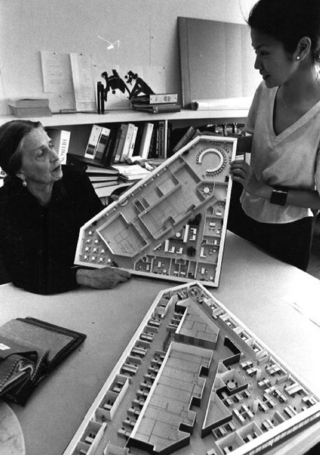Loading AI tools
American architect (1915–2004) From Wikipedia, the free encyclopedia
Edward Larrabee Barnes (April 22, 1915 – September 22, 2004) was an American architect. His work was characterized by the "fusing [of] Modernism with vernacular architecture and understated design."[1] Barnes was best known for his adherence to strict geometry, simple monolithic shapes and attention to material detail. Among his best-known projects are the Haystack School, Christian Theological Seminary, Dallas Museum of Art, the Walker Art Center, 599 Lexington Avenue, the Thurgood Marshall Federal Judiciary Building, and the IBM Building at 590 Madison Avenue.[2]

Barnes was born in Chicago, Illinois, into a family he described as "incense-swinging High Episcopalians", consisting of Cecil Barnes, a lawyer, and Margaret Helen Ayer, recipient of a Pulitzer Prize for the novel Year of Grace. Barnes graduated from Harvard in 1938 after studying English and Art History before switching to architecture, then taught at his alma mater Milton Academy,[3] before returning to Harvard for further studies under Walter Gropius and Marcel Breuer. He graduated from the Harvard Graduate School of Design in 1942 and served in the Navy during World War II. After the war he worked for Henry Dreyfuss in Los Angeles designing prototypes for mass-produced homes.
In 1949, Barnes founded Edward Larrabee Barnes Associates in Manhattan. During his long career, Barnes, with his wife Mary Barnes as interior designer, designed office buildings, museums, botanical gardens, private houses, churches, schools, camps, colleges, campus master plans, and housing. Although best known for the Haystack Mountain College of Arts and other smaller residential homes, the firm also completed a number of master planning urban development projects.
The firm's planning projects include:
Over the years, he also taught at Harvard University, the Pratt Institute, and the University of Virginia, and served as a member of the Urban Design Council of New York and as vice-president of the American Academy in Rome. In 1969, Barnes was elected into the National Academy of Design as an Associate member and became a full member in 1974. He was elected a Fellow of the American Academy of Arts and Sciences in 1978.[4] In 2007, he was posthumously honored with the American Institute of Architects' highest award, the AIA Gold Medal. He also received the Thomas Jefferson Medal in Architecture, the Harvard University 350th Anniversary Medal, and some forty other awards. His Haystack Mountain School of Crafts won the AIA Twenty-five Year Award.
In 1993, Barnes announced his retirement but he continued to work as a consultant for Lee / Timchula Architects, founded by Barnes' lead partner, John M.Y. Lee, and associate, Michael Timchula. Lee / Timchula inherited various projects that the Barnes' office was awarded.
The AIA Board of Directors posthumously awarded the 2007 AIA Gold Medal to Edward Larrabee Barnes, FAIA.
Barnes died in 2004 in Cupertino, California. His archives are located at the Frances Loeb Library at Harvard University.[5] He is laid to rest on Mt. Desert Island, Maine.

Seamless Wikipedia browsing. On steroids.
Every time you click a link to Wikipedia, Wiktionary or Wikiquote in your browser's search results, it will show the modern Wikiwand interface.
Wikiwand extension is a five stars, simple, with minimum permission required to keep your browsing private, safe and transparent.